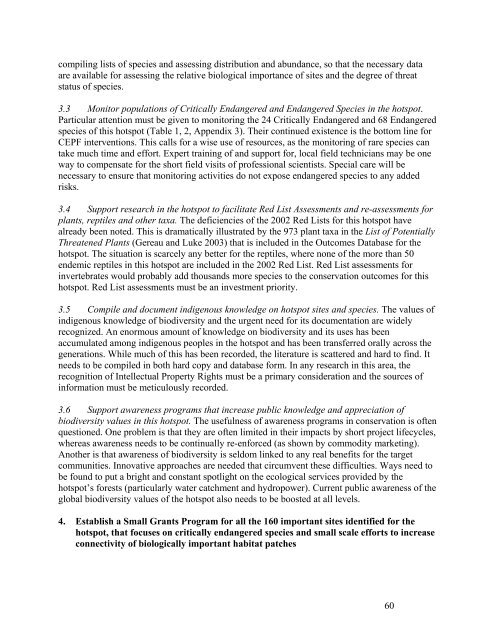Eastern Arc Mountains and Coastal Forests of Tanzania and Kenya ...
Eastern Arc Mountains and Coastal Forests of Tanzania and Kenya ...
Eastern Arc Mountains and Coastal Forests of Tanzania and Kenya ...
Create successful ePaper yourself
Turn your PDF publications into a flip-book with our unique Google optimized e-Paper software.
compiling lists <strong>of</strong> species <strong>and</strong> assessing distribution <strong>and</strong> abundance, so that the necessary dataare available for assessing the relative biological importance <strong>of</strong> sites <strong>and</strong> the degree <strong>of</strong> threatstatus <strong>of</strong> species.3.3 Monitor populations <strong>of</strong> Critically Endangered <strong>and</strong> Endangered Species in the hotspot.Particular attention must be given to monitoring the 24 Critically Endangered <strong>and</strong> 68 Endangeredspecies <strong>of</strong> this hotspot (Table 1, 2, Appendix 3). Their continued existence is the bottom line forCEPF interventions. This calls for a wise use <strong>of</strong> resources, as the monitoring <strong>of</strong> rare species cantake much time <strong>and</strong> effort. Expert training <strong>of</strong> <strong>and</strong> support for, local field technicians may be oneway to compensate for the short field visits <strong>of</strong> pr<strong>of</strong>essional scientists. Special care will benecessary to ensure that monitoring activities do not expose endangered species to any addedrisks.3.4 Support research in the hotspot to facilitate Red List Assessments <strong>and</strong> re-assessments forplants, reptiles <strong>and</strong> other taxa. The deficiencies <strong>of</strong> the 2002 Red Lists for this hotspot havealready been noted. This is dramatically illustrated by the 973 plant taxa in the List <strong>of</strong> PotentiallyThreatened Plants (Gereau <strong>and</strong> Luke 2003) that is included in the Outcomes Database for thehotspot. The situation is scarcely any better for the reptiles, where none <strong>of</strong> the more than 50endemic reptiles in this hotspot are included in the 2002 Red List. Red List assessments forinvertebrates would probably add thous<strong>and</strong>s more species to the conservation outcomes for thishotspot. Red List assessments must be an investment priority.3.5 Compile <strong>and</strong> document indigenous knowledge on hotspot sites <strong>and</strong> species. The values <strong>of</strong>indigenous knowledge <strong>of</strong> biodiversity <strong>and</strong> the urgent need for its documentation are widelyrecognized. An enormous amount <strong>of</strong> knowledge on biodiversity <strong>and</strong> its uses has beenaccumulated among indigenous peoples in the hotspot <strong>and</strong> has been transferred orally across thegenerations. While much <strong>of</strong> this has been recorded, the literature is scattered <strong>and</strong> hard to find. Itneeds to be compiled in both hard copy <strong>and</strong> database form. In any research in this area, therecognition <strong>of</strong> Intellectual Property Rights must be a primary consideration <strong>and</strong> the sources <strong>of</strong>information must be meticulously recorded.3.6 Support awareness programs that increase public knowledge <strong>and</strong> appreciation <strong>of</strong>biodiversity values in this hotspot. The usefulness <strong>of</strong> awareness programs in conservation is <strong>of</strong>tenquestioned. One problem is that they are <strong>of</strong>ten limited in their impacts by short project lifecycles,whereas awareness needs to be continually re-enforced (as shown by commodity marketing).Another is that awareness <strong>of</strong> biodiversity is seldom linked to any real benefits for the targetcommunities. Innovative approaches are needed that circumvent these difficulties. Ways need tobe found to put a bright <strong>and</strong> constant spotlight on the ecological services provided by thehotspot’s forests (particularly water catchment <strong>and</strong> hydropower). Current public awareness <strong>of</strong> theglobal biodiversity values <strong>of</strong> the hotspot also needs to be boosted at all levels.4. Establish a Small Grants Program for all the 160 important sites identified for thehotspot, that focuses on critically endangered species <strong>and</strong> small scale efforts to increaseconnectivity <strong>of</strong> biologically important habitat patches60
















